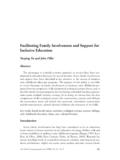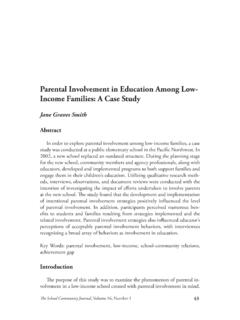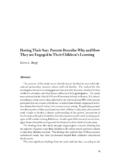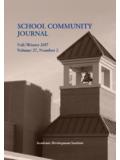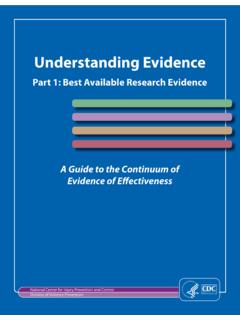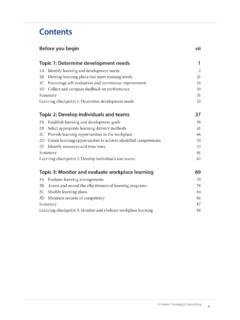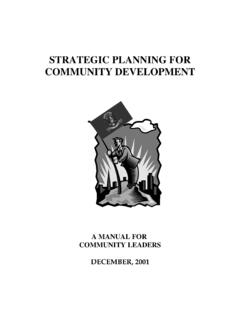Transcription of Using Needs Assessments for School and District …
1 Using Needs Assessments for School and District ImprovementA TACTICAL GUIDEJ ulie CorbettSam Redding2017 ContentsPurpose of Tactical Guide2 ESSA Requirements 3 Section A Planning Your Needs assessment 4 Section B Designing Your Needs assessment 13 Section C The Improvement Process 24 Section D Key Decision Points 37 References 411 PURPOSE OF TACTICAL GUIDEThis tactical guide is designed to support state education agencies (SEAs), local education agencies (LEAs), and schools as they design and complete Needs Assessments for variouspurposes. This guide was created specifically to:2 Support schools identified for improvement (due to achievement data for all students or for subgroups of students) and their LEAs. But anyschool or LEA canbenefit from the use of a strong Needs assessment (NA).
2 Provide SEAs and LEAs with information about how the NA connects into a broader theory ofaction around SEAs and LEAs with specific guidance and questions to consider as they develop a NA or hire an external provider to complete an Needs assessment , and then utilize its results as part of their planning, implementation, and monitoring Requirements3 For schools identified for comprehensive support and improvement (CSI), the District must develop and implement a School improvement plan thatis based on a School -level NA (Title I, PartA). An LEA is not required to conduct an NA for schools identified for targeted support and improvement (TSI), but many SEAs may choose to either require or strongly encourage the completion of an NA for those identified ESSA, a few additional Title areasalso require an NA.
3 In some cases, the same NA, or a very similar one, canbe used to meet more than onerequirement. Some SEAs may also choose to have allschools (and LEAs) that have been identified for improvement complete an NA. To streamline efforts and lessen the burden on schools and LEAs, some SEAs may choose to develop a template for a comprehensive Needs assessment (CNA) that meets of their department-specific requirements for local NAs. The Every Student Succeeds Act (ESSA) requires SEAs and LEAs tocomplete a Needs assessment (NA) in several circumstances, including: (CCSSO, 2017; Department of Education, 2015)Planning Your Needs Assessment4 SECTION AWHAT S IN A NAME?An assessment is anappraisalthat estimates, calculates, or rates something. So, what does it mean to assess Needs ?
4 Basically it means toidentifya School s (and to some extentits LEA s) strengths, weaknesses, and the areasin which improvementis called areas of weakness is an essential first step toward identifying and then addressing root causes of poor names and definitions are used to describe Needs Assessments , including: Comprehensive Needs assessment (CNA) Segmented Needs assessment (SNA) Consolidated Needs assessment Needs assessment Equity audit School quality review (SQRs) Diagnostic assessment Diagnostic review Diagnostic inquiry An NA isa systemic process that is used to:-Determine strengths and weaknesses of a School and/or LEA,-Understand the context and constraints of the School and/or LEA,-Perform a root-cause analysis, and -Develop an improvement plan outlining changes considered most likely tobolster or build on strengths and to remediate weaknesses.
5 An NA should be part of an ongoing performance management cycle that includes both longer-range performance goals and shorter-cycle implementation targets. An NA should include questions at the LEA level, even if the focus is the schoollevel. An NA isnot an isolated tool or practice, but should be partof a continuous improvement process. What is a Needs assessment (NA) for improvement?6 Whole or Part?A Needs assessment (NA) is a point-in-time snapshot that may be: Comprehensive, assessing all aspects of the School and its context (including its LEA), and/or Segmented, assessing only one or a few aspects of the School and its NA should be revisited and updated on a regular basis to ensure alignment to the improvement plan and to check for progress against the original findings.
6 7 Comprehensive Needs Assessments inform: Organizational direction, including goals and strategies Systemic functions Long-range plans (typically multi-year)Segmented Needs Assessments inform: Improvement to targeted functions or aspects of the School Incremental change Short-cycle plans (typically less than a year) A CNA may be used by multiple departments within an SEA. Instead of having several individual departments develop or require their own NA templates for local use, the departments collaborate to develop a single template that will work for all of them. The initial amount of time invested in creating a CNA can be large, because it includes developing the necessary tools and processes, as well as planning and coordinating related to implementation.
7 However, this approach can result inresource savings for the SEA, the LEA, and the schools over time. As is true for all NAs, the findings yielded through a CNA are only accurate as long as the School and District context remains the same. Thus, CNAs need to be updated as the School and its LEA evolve. Developing a CNA would be most beneficial for SEAs that are moving toward implementing consolidated grant applications; are braiding and blending funds; and are breaking down traditional SEAsilos. Comprehensive Needs assessment (CNA)8 Segmented Needs assessment (SNA) An SNA is:-used by one program or a limited number of programs within an SEA, and/or-used by a School to address one functional area or a limited number of functional areas at a time, to inform short-cycle improvement planning.
8 An SNA can be conducted relatively quickly, thus allowing for opportunities to capture and learn from the most current data. An SNA may be produced by administering each component of a CNA separately so that improvement in each area can be planned and executed as a manageable chunk of work. This approach retains the CNA's advantage of providing a coherent view of how the components fit OF Needs ASSESSMENTThe instruments and methods needed for conducting a CNA or an SNA may vary by School types and performance School , middle School , elementary School , preschool; typical or special-purpose School (alternative schools, for example)Trajectory of past performance ( Using accountability metrics, for example)Performance Tools & Infrastructure Guidance Consistently highperformance School will be able to apply SEA- and LEA-provided tools, data, implementation infrastructure, and information to its own advantage Self-directed.
9 Will access the resources and supports required for [its]continued growth Moderate performance/rapid improvement School will typically be able to apply the SEA- and LEA-provided tools, data, implementation infrastructure, and information to its own advantage Self-directed; will access the resources and supports required for [its]continued growth Moderate performance/ moderate improvement School will benefit from coached self- assessment , applying the SEA- and LEA-provided tools, data, implementation infrastructure, and information Guidance of an external consultant would be helpful in diagnosis and planning Moderate performance/slow improvement Coached self- assessment may be supplemented by external reviews to provide an objective view of School s operations, implementation infrastructure, and recom-mend improvements Needs coaching and external reviewers for diagnosis and planning Consistently lowperformance School is a candidate for intervention.
10 External review is useful in determining the appropriate intervention and implementation infrastructure model to inform the SEA and LEA about conditions and practices prevalent in the School in order to strengthen the reform efforts Needs interventionists and external reviewers for diagnosis, planning, and strategy selection 11 Source: Excerpted from Redding, S., Dunn, L., & McCauley, C. (2015). School Improvement Grants: Guidance and tools for the 2015 amended regulations: Maximizing the optional planning/pre-implementation year. San Francisco, CA: WestEd. Retrieved from Used with BY PERFORMANCE TRAJECTORYThis is an example of how performance trajectory could inform the Needs assessment and improvement statement for your NA: The purpose of this NA is to.



